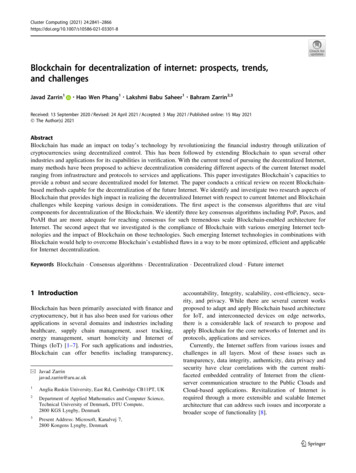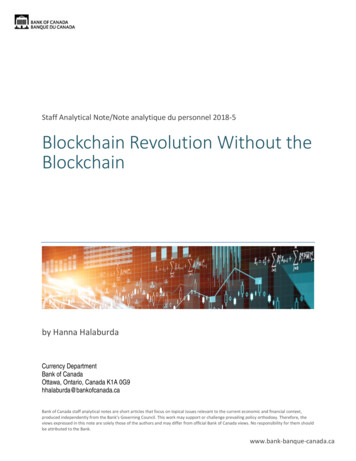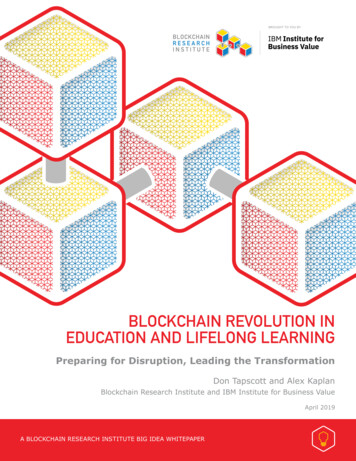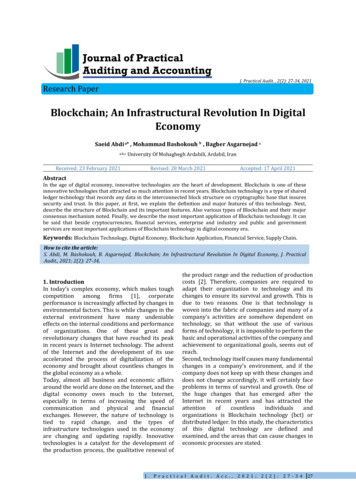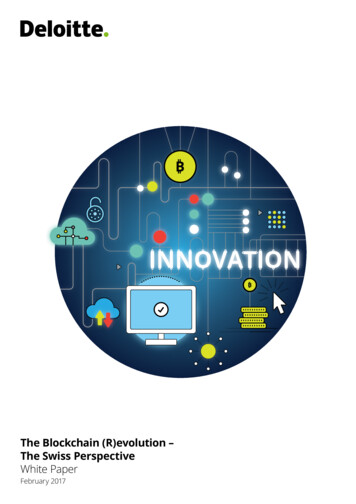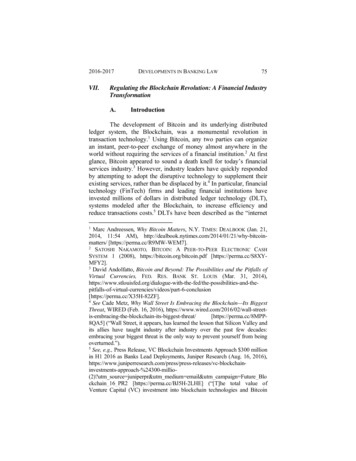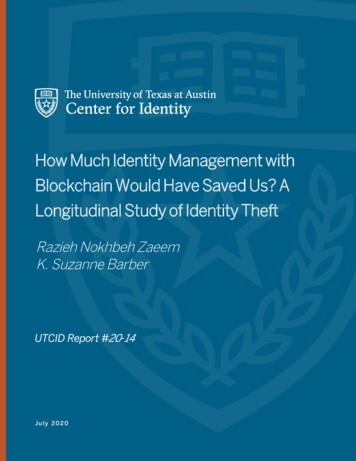
Transcription
MAY 2018Blockchain and thedecentralization revolutionA CFO’s guide to the potential implications of distributedledger technology
Authored jointly by J.P. Morgan’s Corporate FinanceAdvisory, Digital Investment Banking, and Blockchain Centerof Excellence teamsFor questions or further information, please contact:Corporate Finance AdvisoryRama 2) 834-4693Evan Junekevan.a.junek@jpmorgan.com(212) 834-5110Anca Saperiaanca.r.saperia@jpmorgan.com(212) 834-2092Digital Investment BankingHuw Richardshuw.richards@jpmorgan.com(212) 834-8340Blockchain Center of ExcellenceChristine Moychristine.moy@jpmorgan.com(212) 622-0283
BLOCKCHAIN AND THE DECENTRALIZATION REVOLUTION 11. IntroductionA query for “blockchain” on Google’s news aggregator returns 160 matches for the monthof April, 2018, alone. The media’s interest in blockchain, or “distributed ledger,” technologyand the associated “crypto asset class” over the last 12 to 18 months has mirrored the rapiddevelopment of the blockchain ecosystem. The figures are startling (Figure 1):Figure 1Blockchain by the numbers 6 Billion 1.7 BillionCapital raised via Initial CoinOfferings (ICOs) in Q1 2018Largest ICO to-date1 406 Billion1,500 Current market value of allcryptocurrency in circulationCryptocurrencies in circulation 6.5 Billion86,000 Bitcoin’s average daily volume2Existing blockchain projects,including the bitcoinSource: Coinschedule.com, GitHub, Coinmarketcap.com; market data as of 04/30/20181 According to Form D filings from 02/2018 and 03/2018 00095017218000030/xslFormDX01/primary doc.xml, 0095017218000060/xslFormDX01/primary doc.xml) Telegram ICO (pre-sale) dated March 2018230-day average daily traded volumeWhile a lot has been written about blockchain, and its most media-friendly implementation,bitcoin, there has been less focus on the potential corporate use cases of the blockchainconstruct. This document will attempt to explain the technology in non-technical terms, providean update on the current status of blockchain, and summarize an action plan for corporatedecision makers to evaluate blockchain’s potential. We will also attempt to clearly outline thepotential uses of blockchain while also highlighting the various risks and shortcomings thathave been identified to date.This is not a technical document. Many have filled that need in their white papers and referencematerials. Rather, we seek to provide an informed view on the corporate implications of therapidly changing interplay between finance and blockchain technology.See a term thatyou don’t know?Check out the Glossary atthe back of this document.
2 Corporate Finance Advisory2. Blockchain basicsUnderstanding the blockchain basics is crucial to being able to evaluate the technology’smore sophisticated potential applications. So what is blockchain? Figure 2 provides a formaldefinition and a corresponding explanation in “plain English.”Figure 2Defining blockchainBlockchain characteristics in plain EnglishA data store holding a log, orledger, of transactions (events)A blockchain is a databaseDistributed across a public orprivate networkMultiple identical copies of the databaseare held by participants in the blockchainnetworkUsing cryptography and hashingtechniques to determine validparties and transactionsMathematical algorithms create uniqueelectronic “fingerprints” for networkparticipants and any piece of dataSuch that everyone agrees onthe order and state of the ledger,without having to rely on a trustedthird partyA consistent version of the database ismaintained using predetermined rulesassociated with verifying the “fingerprints”of those associated with changes to thedatabaseWith a practically immutable,verifiably true audit trailThe entire, unalterable transaction historyhas become the database itselfSource: J.P. MorganEven in simplified terms, blockchain technology includes some interesting characteristics.The distributed nature of the database means that information in the blockchain system isduplicated and resilient to network attacks. The use of encryption to “fingerprint” and validatedata enhances the security of the overall system and also results in the side effect of acomprehensive and immutable audit trail. And perhaps most interesting, the development ofalgorithms to distribute the responsibility of validating changes to the blockchain’s database(or “ledger”) provides a feasible alternative to maintaining a central validating authority.This notion of “decentralized trust” is a key attribute of blockchain that excites many of itsproponents. Consider a simplified illustration of a common occurrence: A company, PayerCo,wishes to send 100 to a supplier, SupplierCo. In the centralized model, both PayerCo andSupplierCo would trust a central authority—a bank—to establish that PayerCo and SupplierCowere who they said they were and that PayerCo had 100 to send to SupplierCo. To the extentthe bank deems the transaction valid based on these prerequisites, PayerCo’s account isdebited by 100 and SupplierCo’s account is credited by 100. In this model the bank remainsthe central authority and maintains a single copy of the ledger which reflects past transactionsand current account balances.
BLOCKCHAIN AND THE DECENTRALIZATION REVOLUTION Now consider a decentralized approach on a blockchain network. In this scenario, PayerCoand SupplierCo would be merely two entities in the broad payment network. PayerCo andSupplierCo each would have identical copies of the ledger and the details of PayerCo’s 100payment to SupplierCo, which would be broadcast to all entities on the payment network.Other entities on the payment network evaluate their own copies of the ledger to validate thetransaction (e.g., does PayerCo have 100 to send?) and through a consensus algorithm agreeon the updated state of the ledger, which in this example results in PayerCo’s account beingdebited 100 and SupplierCo’s account being credited 100.Figure 3Centralized vs. distributed ledger approaches: Finding trust in the networkDataPayerCoClearing ServiceSupplierCo 100Shared Prime RecordDataBankPayerCoDataSupplierCo 100Prime Record 100Source: J.P. MorganThe implementations of these consensus algorithms vary significantly. In the bitcoinimplementation of blockchain, network participants run computationally challenging mathproblems in order to “vote” on the validity of a proposed transaction (and are rewardedfor their efforts via the receipt of bitcoin through a process referred to as “mining”). Thisapproach is required because the bitcoin network is public and trust amongst entities cannotbe assumed. Alternative implementations of blockchain would most likely include “trusted”network participants who may validate proposed transactions under any circumstances—effectively a hybrid of a centralized and distributed approach.While this description glosses over numerous technical details and simplifies many others,hopefully it is clear that blockchain technology has several benefits worthy of close evaluation.However, while some have fallen victim to thinking of blockchain as a panacea to the IT woesof global corporations, blockchain technology comes with several potential hurdles, especiallyin the near-term (Figure 4).3
4 Corporate Finance AdvisoryFigure 4Blockchain adoption: Short-term hurdles vs. potential long-term benefitsPerceived short-term hurdlesPotential long-term benefits I nvestment in new systemsinfrastructure: Managing a trade-offbetween short-term investment vs. longterm potential gains C osts reduction: Infrastructurecosts reduced in data management,reconciliations, settlement,administration, etc. T echnical hurdles: Challenges relatingto scalability, data privacy, technologystandardization, speed of execution,interoperability with existing systems G reater liquidity: Ability to monetizeexisting assets via “tokenization” S ecurity concerns: Well-publicized issuesin the cryptocurrency space may driveperception of security risk S ecurity enhanced: Cryptographyensures ledger is immutable, andpermissioned platform providesadded security E fficiency improved: Speeding upprocesses by permitting transactionswithout the need of a trustedthird party Enhanced transparency: Providesgreater transparency with an auditabletransaction log, and mitigates counterparty riskSource: J.P. MorganIt is worth closing this blockchain overview by addressing a common point of confusion.Blockchain is not bitcoin. Bitcoin is a digital currency independent of any central authority.While it is certainly a seminal implementation of blockchain technology, it is only a singleuse case. Whether bitcoin survives or not, the underlying blockchain technology is likely hereto stay. To draw a similar analogy, bitcoin is to blockchain what America Online was to theinternet. Bitcoin has been the introduction to blockchain technology for many people just asAOL was an introduction to the internet for many in the 90s. As the complete ramifications ofthe internet are still being understood, the implications of blockchain are also just beginningto be imagined.
BLOCKCHAIN AND THE DECENTRALIZATION REVOLUTION 3. Corporate finance implications of blockchain inthe enterprise contextLike any emerging technology, the potential implications of blockchain seem both vast andat the same time not fully comprehensible. Many in the popular press have speculated aboutblockchain-driven notions as diverse as the development of borderless global currencies to thecreation of fraud-proof voting tools to help eliminate electoral corruption and fraud. We maynot yet even fully comprehend blockchain’s “killer app.”For corporate finance professionals, however, the potential implications of blockchain aremore tangible. Figure 5 illustrates three primary use cases of blockchain likely to be the mostrelevant in the corporate finance context:Figure 5Primary blockchain opportunities for corporate finance professionalsUse caseSupply chainObjective Create an auditable and sharedtransaction log to provideassurance and validate productsin the supply chainObservations Shared platform lends itselfto interoperation betweensuppliers and customers Enhanced transparency drivesopportunities for optimizationand cost reduction Many individual company andindustry pilots underwayFinancing Improve existing capitalmarkets via decentralizationand programmatic contractenforcement to further enhancethe connectivity of capitalissuers and capital providers Utilize a “digital asset”construct to create newforms of capital with uniquecharacteristicsPayments andsettlement Transparency of transactionsover time to all marketparticipants Reduce settlement time to T 0Source: J.P. Morgan Enhancement of existingcapital markets offers thepotential to reduce costs andcounterparty risk New types of capital (coins/tokens) could offer firmsnew avenues of liquidity andpossibly reduce the overall costof capital Transparency of transactionsallows all participants to viewthe entire transaction lifecycleand provides an auditable log5
6 Corporate Finance Advisory4. Supply chainToday’s supply chain networks have exponentially increased in complexity as companies andmarkets have become more global and distributed. S&P 500 firms alone have more than 33,000direct suppliers and more than 26,000 direct customers.1 These customers and suppliers inturn have their own suppliers and customers, creating a complex but highly interdependentnetwork of relationships.This complexity and interdependence amongst different counterparties illustrates thechallenge of supply chain optimization, but few finance professionals would dispute thepotential financial benefits. Let’s consider supply chain optimization in the context of ourearlier blockchain definition:A blockchain is:A data store holding a log, or ledger, of transactions (events): Managing a supply chain is, atthe very least, a management of transactions. Being able to store those transaction details inan accessible database is key to any supply chain optimizationDistributed across a public or private network: The inherently “distributed” nature of anyfirm’s supply chain would lend itself to a form of distributed network where all participantsin the supply chain effectively hold a copy of all the relevant supply chain information (OEM,suppliers, end customers, etc.)Using cryptography and hashing techniques to determine valid parties and transactions:Blockchain’s embedded security features provide supply chain participants a unique digital“fingerprint” that ensures only authorized participants can make changes to the record oftransactions. One tangible impact of this would be reduced concern of counterfeitingSuch that everyone agrees on the order or state of the ledger, without having to rely ona trusted third party: A network of supply chain participants could rely on the network tomaintain the state of the database, without relying on a centralized authority who mightotherwise use it to extract concessions in the supply chain contextWith a practically immutable, verifiably true audit trail: A complete log of all transactionsacross the entire supply chain would be maintained in an unalterable state, enhancingaudit capabilitiesSo a blockchain solution would fit the supply chain use case very well, potentially increasingtransparency and ultimately efficiency, and drive cost savings. Not surprisingly, many firms areactively working towards developing supply chain proof-of-concepts. One crucial aspect of anyblockchain solution, however, is mass adoption: Only when the supply chain participants canagree on a common blockchain solution would the full benefits be realized.Supply chain short-term hurdles vs. potential long-term benefitsPerceived short-term hurdles G etting suppliers to join the network:The idea of sharing data as part ofa distributed ledger could hinderparticipation of suppliers who mightworry about competitive implicationsPotential long-term benefits E nhanced capability to manageoperations/processes: Completelog of transactions across the entiresupply chain would improve auditcapabilities R educed counterparty risk: Transactionsvalidated by the blockchain network I mproved customer experience:Provide retail consumers of goodsmore information about the origins ofproductsSource: Bloomberg, J.P. Morgan as of 04/20181
BLOCKCHAIN AND THE DECENTRALIZATION REVOLUTION 5. FinancingThe potential ramifications of blockchain on corporate finance are difficult to understate.Even in its relatively nascent state, blockchain offers numerous potential options for financeprofessionals to ponder as the technology develops. We evaluate two distinct possible impacts:Blockchain as capital markets 2.0Like the supply chain use case, existing financing markets have characteristics that naturallylend themselves to the features of blockchain technology: Numerous participants, seekingto maintain a record of ownership, and reduce friction costs. Let’s consider how financingmarkets might fit the blockchain mold:A blockchain is:A data store holding a log, or ledger, of transactions (events): Financing markets are theamalgamation of records of ownership and transfer of value. A ledger is crucial to understandingthe state of the market at any moment in timeDistributed across a public or private network: An effective financing market needs to havehigh resiliency and availability; a distributed database can help to maximize market uptimeand mitigate the potential instability of network participantsUsing cryptography and hashing techniques to determine valid parties and transactions:Blockchain’s cryptographic underpinnings can help ensure the security and validity ofasset ownershipSuch that everyone agrees on the order or state of the ledger, without having to rely on atrusted third party: A network of financial market participants could rely on the network tomaintain the state of the database, without relying on a centralized authority. Alternatively,a permissioned blockchain could allow a set of trusted market participants (e.g., banks andmarket makers) to validate transactions and maintain the state of the networkWith a practically immutable, verifiably true audit trail: A complete log of all transactionsacross the entire financial market would be maintained in an unalterable state, enhancingaudit capabilities and streamlining the clearing processBlockchain also has the potential to offer functionality not currently available to capitalmarkets participants. Consider a traditional bond security: An investor buys a bond thathas behavior defined in a prospectus (that includes a given maturity date, coupon, paymentschedule, etc.). The investor and issuer enter into a contractual arrangement enforced byvarious legal and regulatory underpinnings that ensure the investor receives interest andprincipal in all but (hopefully) extreme default scenarios. In a blockchain or distributed ledgerimplementation, this contractual arrangement could be defined and enforced by the networkitself. That is, a “blockchain bond” could make periodic interest payments and ultimately matureprogrammatically. This notion of a blockchain “smart contract” provides the capabilities todigitally facilitate, verify, and enforce the execution of a contract. Enforcement of contractualagreements is a lengthy and costly process in both developed and underdeveloped markets(Figure 6), and smart contracts could significantly reduce transaction costs, time to enforce,and counterparty risk. The potential benefits of smart contracts aren’t limited to the capitalmarkets: To the extent certain kinds of assets (e.g., real estate) are managed on a blockchainframework, there could be implications for M&A, as well.7
8 Corporate Finance AdvisoryFigure 6Enforcing contract law programmatically may have significant benefits globallyEurope & Central AsiaTime to enforce (days)490East Asia & Pacific566OECD high income578Middle East & North Africa639Sub-Saharan Africa657Latin America & CaribbeanSouth Asia7671,102Source: The World BankNote: The enforcing contracts indicator measures the time and cost for resolving a commercial dispute through a localfirst-instance court, and the quality of judicial processes index, evaluating whether each economy has adopted a seriesof good practices that promote quality and efficiency in the court system. The most recent round of data collection wascompleted in June 2017Work is already underway to improve existing capital markets by extending them ontoblockchain implementations. These changes are likely to be transparent to existing capitalusers and providers since they will rely on developing solutions in the context of existingforms of capital. This is not to say you’ll be day trading on the blockchain anytime soon.Blockchain technology today still suffers from significant limitations around scalability andtransaction processing speed. However, financing markets that ultimately depend less oncentralized market authorities and more on a distributed framework of ownership have,at the very least, the potential to increase efficiency, improve market transparency, andlower costs (Figure 6).Over the past 18 months, J.P. Morgan’s Debt Capital Markets business has spent considerabletime evaluating how distributed ledgers can be an opportunity for both industry thoughtleadership and capital markets transformation. Dromaius (J.P. Morgan’s Capital MarketsBlockchain Proof of Concept Platform) is creating a decentralized market for digitalassets, designed to allow direct transacting between issuers and buyers and to provideanalytics-driven, frictionless, rules-driven liquidity management solutions. In this evolvingcapital markets environment, blockchain technology should ultimately be able to helpconnect borrowers and lenders and facilitate an enhanced and more secure marketplacewhere transactions are recorded and validated by network participants and corporatescan achieve ongoing access to capital markets.In April 2018, National Bank of Canada, with the support of J.P. Morgan, issued a 150 million, one-year floating-rate Yankee certificate of deposit, with a parallel simulationof the issuance using blockchain technology. The blockchain debt issuance applicationwas designed to incorporate functions across the entire debt instrument transactionlifecycle, including origination, distribution, execution, settlement, interest rate payments,and maturity repayments. This transaction demonstrates the technology’s capabilities andcapital markets implications.
BLOCKCHAIN AND THE DECENTRALIZATION REVOLUTION Financing short-term hurdles vs. potential long-term benefitsPerceived short-term hurdlesPotential long-term benefits G etting regulators on board: IRS/SEC toapprove issuance and trading O ngoing and easy access to capitalmarkets: Enhanced liquidity and abilityto raise capital in a streamlined processvia crowdfunding I ncremental capital structurecomplexity: New definitions for fit inthe capital structure and impact onexisting securities would need to beevaluated by accountants/lawyers;CFOs and treasurers might be reluctantto add capital structure complexity G reater liquidity: Ability to monetizeexisting assets via tokenization L ower cost of capital: Reducedtransactions costsSource: J.P. MorganBlockchain as a facilitator of new forms of capitalPerhaps one of the most visible aspects of the rapid development of blockchain technology hasbeen the emergence of so-called “Initial Coin Offerings” or ICOs. These structures have allowedfirms to raise money in exchange for digital “coins” or “tokens” to be traded on blockchainnetworks. So what is this new form of “coin” capital? In short, just about anything you canthink of. It is a digital representation of value. This value could reflect something physical(e.g., real property) or more conceptual (e.g., copyright ownership). If that construct isn’tabstract enough, consider that a coin doesn’t have to simply be a static representation ofvalue but rather can also have dynamic characteristics as defined by smart contracts, asdiscussed above.Amazingly, many firms have accomplished these fundraising objectives before the developmentof the digital coin or associated marketplace has even taken place. This form of industrialstrength crowdfunding raised almost 4 billion in 2017 and almost 6 billion in the first quarterof 2018 alone (Figure 7), outpacing the capital raised in the first quarter by VCs for informationtechnology start-ups!Figure 7Initial Coin Offerings (ICOs) are increasingly being adopted as a mechanism for raisingcapital but regulatory uncertainty remains a hurdle for wider adoptionVC funding (information technology) vs. ICOs over time ( mm)VC funding (information technology) 5.4 5.0 0.2 5.4 4.6 4.0ICOs 5.8 5.8 5.2 4.7 4.6 0.9 1.22017 summary ( bn) 20.6 1.7 0.0 0.0 0.1 0.0Q1 2016 Q2 2016 Q3 2016 Q4 2016 Q1 2017 Q2 2017 Q3 2017 Q4 2017 Q1 2018 3.92017Source: PitchBook, Coinschedule.com; Note: VC funding includes Seed, Series A and Series B funding stagesNote: Market data as 03/31/20189
10 Corporate Finance AdvisoryMany of the ICOs described above have been issued without any future promise of return ofprincipal or rights to interest (so they are clearly not debt) but they also have avoided offeringvoting rights or rights to cash flow typical of equity. This suggests that blockchain technologyhas facilitated the creation of a new asset class, and potentially a new form of capital. But italso raises the question of where investors see value in these structures. One possible answeris in the potential network effect of a successful coin, whereby current investors seek theopportunity to get in early on a technical solution that becomes a de facto standard for theemerging digital asset class.While mostly start-ups have been quick to seek ICO monetization opportunities based on thisnetwork effect potential, incumbents with large existing user bases (Figure 8) may be evenbetter positioned to be the new standard-bearers. For example, companies could issue “utility”tokens that users would purchase and use to pay for services; leveraging a blockchain platformto connect billions of customers could eliminate traditional intermediaries, reduce transactioncosts, and expand the customer base.Figure 8ICOs might be interesting for companies with large user-based networks; selectedcurrent networks (in millions)Visa (number of cards)3,200Facebook (number of monthly active users)2,200WhatsApp (number of users)1,500Apple (number of active installed base)1,3001,000WeChat (number of users)LinkedIn (number of users)546Paypal (number of active accounts) 227Spotify (number of active users)157Netflix (number of members)125Marriott (number of loyalty program members)110Amazon Prime (numbers of members)100Source: Company filings, company presentations, Techcrunch.com, brokers estimatesFor more traditional capital issuers let’s consider how blockchain “coins” might challenge theconventional corporate finance perspectives:Debt or equity? Precedent ICOs suggest there is an investor base for capital that possessesneither explicit debt nor equity characteristics. This has significant ramifications for thoseseeking to raise capital, since it potentially offers enhanced financial flexibility, possible creditrating flexibility, and limited dilution. For existing capital providers, the addition of coins tothe capital structure offer both benefits and pitfalls: A coin issuance might diversify fundingsources and enhance credit quality, or it might subordinate a capital provider’s right to cashflows. The inherent flexibility of the coin construct means that different structures may havedifferent impacts on the rest of the capital stack.
BLOCKCHAIN AND THE DECENTRALIZATION REVOLUTION Accounting treatment? For all the uncertainty of how coin offerings might be viewedeconomically, accountants have only so many options for reflecting a coin issuance on thebalance sheet. While treatment differs subject to the exact circumstances, most have beenaccounted for as debt, equity, or deferred revenue.Speed to market? Unlike IPOs or even debt offerings that typically require extensiveregulatory filings, investor marketing, and execution timelines, ICOs have been rapid turnaround exercises. Many have used techniques similar to popular “crowdfunding” websitesto raise funds from anyone with an internet connection. Heightened scrutiny from the SEChas definitively slowed the process and increased scrutiny, particularly for those whohoped to avoid securities registration, but the process illustrates the potential for disruption inthe more traditional capital raising venues.Regulatory hurdles? Coins as a capital raising tool remain very much new technology. AllICOs transacted to date were done by start-up stage companies seeking to raise moneyfrom venture capitalists and other early-stage investors who may more fully appreciatethe future potential of a given coin. In a statement made by SEC Chairman Jay Clayton inDecember 2017, it was noted that no ICOs to date had been SEC-approved or registeredofferings.2 Chairman Clayton also emphasized that “the structures of [ICOs] that [he] has seenpromoted involve the offer and sale of securities.” While the SEC’s comments emphasizetheir commitment to promoting capital formation, this commentary suggests that ICOsand other strategies involving “crypto” assets are likely to receive additional scrutiny. Morerecent comments by the SEC clarifying that online platforms that facilitate the tradingof digital assets (e.g., coins or tokens sold in ICOs) must register with the SEC as nationalsecurities exchanges (or be deemed exempt) also underscore the incremental regulatoryscrutiny, but also the speed at which the market may mature.3 Legal definitions, accountingstandards, and tax treatment will all need to be determined to provide comfort for largecorporations to utilize this new source of capital.Should you contemplate raising capital through an ICO? It is tempting to look at the amountof capital recently raised through ICO processes and ponder the opportunities for raisingcapital via one’s own coin issuance. In practice, the potential for a successful coin issuanceis very fact-specific. A potential coin issuer requires the technical prowess to implementa public technology solution and manage the associated challenges and risks. An issuerwould also have to navigate what is currently a highly complex but navigable regulatoryenvironment while also ensuring that such a capital raising endeavor didn’t havenegative consequences for other capital providers. While these challenges are surmountable,and are likely to become more so as the technology develops, firms consideringraising capital via ICOs today are very much early adopters and are likely to encounternumerous hurdles, accordingly. The rapid rise of the ICO market, however, serves to illustratethe potential impact of new technology, and blockchain, specifically, applied to oldcorporate finance problems.Source: SEC Chairman Jay Clayton, Statement on Cryptocurrencies and Initial Coin Offerings (December 11, tement-clayton-2017-12-11)3 Source: Statement on Potentially Unlawful Online Platforms for Trading Digital Assets – Divisions of Enforcement and Trading andMarkets (March 7, 2018, rms-trading)2 11
12 Corporate Finance Advisory6. PaymentsAs a bank, we are keenly aware of some of the inefficiencies and redundancies in our owncore businesses. The process of making cross-border payments through networks ofcorrespondent banks is an area admittedly rife with such inefficiencies. Figure 9 illustrates atypical cross-border payment facilita
Blockchain adoption: Short-term hurdles vs. potential long-term benefits It is worth closing this blockchain overview by addressing a common point of confusion. Blockchain is not bitcoin. Bitcoin is a digital currency independent of any central authority. While it is certainly a seminal implementation of blockchain technology, it is only a single


